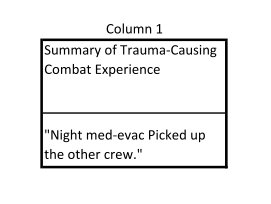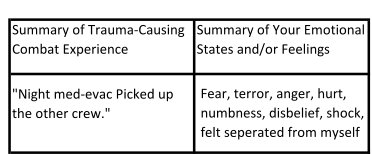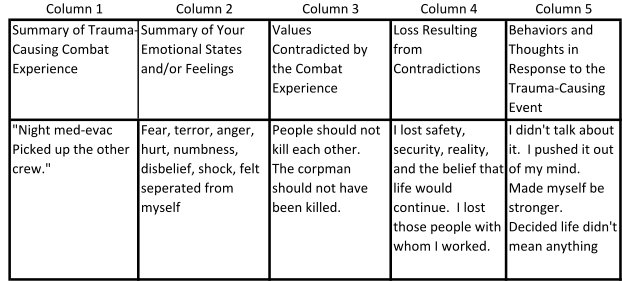This is the second TRT instructional aid for combat veterans. The pamphlet number is:
IV-Dd
This material is for TRT participants. It also provides family members and friends information about the TRT program so that their support for the participant may be enhanced. The TRT Educational Program, including this material, is not intended for general interest reading. It is not a solicitation to engage in TRT. Neither is it authorization to provide TRT to anyone. TRT is authorized for use only under the supervision and facilitation of a Certified TRT Counselor. The authors of TRT, and or their designates, are the TRT certifying authority.
Welcome to TRT Phase Two
If you have just completed the first phase of TRT you are to be congratulated for your hard work, the investment you have made in yourself and the understandings you’ve derived from what surely was strenuous effort. Describing the sources of trauma and your emotional responses to them is the most difficult aspect of the trauma resolution process. No one completes that part of the TRT experience without having applied themselves fully.
Now that identifying, preparing and sharing the specific descriptions of the trauma-causing events is behind you, you are ready to begin TRT Phase Two. For reasons that will become clear as you progress through this pamphlet, this second phase is often called the “Matrix.” Although you may proceed through this part of TRT much more rapidly and with less emotional difficultly, the “Matrix” will probably have a no less profound effect on you than did the beginning phase.
The Matrix
To complete the loss-resolution process, each of the individual losses resulting from the trauma causing experience must be fully reconciled. Before this can occur, the loss must be properly identified and then shared with others. That identification is the primary purpose of the Matrix.
The Matrix is a five-column form that is applied to each trauma-causing event and its effects. If you follow the directions for completing the Matrix (Figure 1), the form itself will take you through the majority of TRT Phase Two.
Fig. 1. The Matrix (TRT Phase Two)
 Steps in Completing the Matrix:
Steps in Completing the Matrix:
Summarize the Event
The first column requests that you summarize the trauma-causing incident. It is important that the summary be as brief as possible – a few words expressed as an incomplete sentence. For example, the trauma-causing combat experience (described in pamphlet #IV -Cc, Pg. 5) would be applied to the first column of the matrix as:
Such a restated, abbreviated description has two purposes. First, it serves as a transition from the individual’s intense focus on the event, as provided by Phase One, to a focus on the effects of that event. Second, this description speaks of the event as an objective happening that is now being reported on rather than as a more directly involving experience, as in Phase One. Now that the emotion is being addressed fairly, this objectivity helps to place the event into its true perspective as something that happened in the past rather than continue to carry the event in the subconscious as a continuing experience.
Steps in Completing the Matrix: Summarize Feelings
The second column is a summary of your feelings in response to the trauma-causing event. This summary includes both the emotions you felt at the time the event occurred and those felt later while thinking back on the episode. For example, in pamphlet #IV -Cc, the veteran described his emotional experience of the crew’s rescue as fear, terror, and numbness. All of these emotions and states[1] would be placed in Column 2 along-side the abbreviated description of the trauma-causing incident.
In Phase One, the initial description may have been so difficult to remember and then to convey that some of the emotion was not recalled. While you are studying what should be placed in column 2 of the Matrix, you should find that the past experience is made even more clear as you begin to move through the remaining emotional aspects of the loss-resolution process. Such feelings as embarrassment, anger, depression, hurt, guilt and sadness are experienced automatically as a person progresses further toward loss reconciliation.
Regardless of whether the feelings are recognized as something that was felt years ago but left unexpressed or as being felt today for the first time in response to the event, we ask that they be recorded in the second column.
The second column also addresses one of the most important aspects of the loss-resolution process. When an individual is exposed to trauma-causing events, the emotional/physical state into which the person enters for immediate protection is shock. This is why most attempts to explain trauma reflect “shock from violence” as the principal definition.
Even though shock is protective, there is a problem with it. Yes, it functions positively as a transition buffer against a too-rapid and un- planned change in reality (one explanation of trauma), but it also inhibits people from using their faculties fully. What is worse, most people don’t know that the state of shock is present. When the incident is described through TRT, the shock is relived, only this time you are helped in understanding how it feels. Indicators of shock are expressions such as “I can’t believe this happened,” “numbness,” “disbelief,” a physical/psychological “fuzziness,” “confusion,” denial, “disorientation” and the feeling of being separated from one’s self. If you find yourself saying or feeling any of these things, be sure to add the word “shock” to the second column with the other expressions.
Again using the veteran’s combat experience as the example, completed columns 1 and 2 would appear as follows:
Steps in Completing The Matrix: Identify Contradicted Values
The third column in the matrix specifies contradicted values: what was it about the event that was contrary to your ideas of what “should” or “should not” be? Be sure here to focus on personal rather than professional values. Professional training values for combat personnel accept behavior that takes human life as a necessary aspect (and risk) of war. However, personal values seldom coincide with such behavior. Consequently, in the IV -Cc example of the combat experience, the veteran’s personal values contradicted were that people should not kill each other. Another belief was that the corpsman was a medical person and shouldn’t have been killed. These contradicted values would be reflected in the Matrix along-side the summaries of trauma-causing behaviors and resulting emotions as follows:
Steps in Completing the Matrix: Identify Losses
The fourth column of the Matrix helps you identify the loss or losses that resulted from the contradicted values. To complete the column, simply ask yourself: “What did I lose as a result of these contradictions?” In the example we have been using, the veteran reported losing a sense of safety, security, and the belief in the continuity of life. He also lost those people with whom he worked and a sense of what was real. The Losses are listed in the Matrix: (see Appendix A for an additional explanation of losses)
Steps in Completing the Matrix: Listing Responses
The fifth column of the Matrix addresses both your thinking about and your behavioral response to the trauma. This requires describing, as briefly as possible, what you thought and did after the trauma was over. Because there may have been many responses and because, as we shall see later in Phase Three, they may have been repeated during other experiences, we ask that you describe at this point only those things that stand out in your mind. Continuing our example, when the fifth column is aligned with the others, the complete representation of one experience of trauma appears in the Matrix as follows:
The Next Step
Before you apply the Matrix’s form to the rest of the incidents of trauma, check each space to ensure that all the information you wish to place there is properly recorded. Then move on and repeat the steps for each succeeding trauma- causing event you described in Phase One. The average number of incidents recorded per page is 5.
Two things are important here. First, do not place any descriptions of combat experiences into the Matrix’s configuration if those incidents were not written about and then shared in Phase One. It is important that each incident be given its full opportunity for detailed expression of what happened and what was felt before the more cognitively oriented Matrix is applied. If you remember such an experience while working on Phase Two, discuss it with your TR T counselor so that the incident can be addressed in the proper sequence.
Second, if you’re not able to confine your writing to a Matrix the size of the example in figure 1, you may draw a larger-scale model of your own. For this, most people use 8 1/2 x 11 inch paper placed horizontally so that the five columns are spread across the paper’s widest dimensions. Other dimensions of paper may be used as long as all five columns are kept together on one page. This way, the broadest perspective on the many related direct effects the incident had on you is available. The result is a much better understanding of the experience than you would have if you separated the five columns onto different pages.
Reading the Matrix
The reading process in Phase Two is considerably different from the reading of the descriptions of the trauma-causing incidents in Phase One. In that program (See Giving Feed- back in TRT), reading was sporadic and periodic and a process of the group’s and each participant’s combined efforts at sharing each experience. In Phase Two, once enough incidents have been read to verify that the participant has the right idea, the person may schedule a special time in which the Matrix can be read in its entirety in one sitting. The point is that this phase serves, not only as a means of identifying, expressing and accepting losses resulting from the specific trauma-causing events, but also to frame the entire cluster of losses as a single event.
In some cases, of course, there will be too many incidents to read in one sitting. Consequently, if you have 25 or fewer incidents, the reading portion of Phase Two might be completed in one or, more often, two to three sessions. If you have a greater number of descriptions, a balance to the reading process is usually achieved in which the number of incidents reflected through the Matrix in each reading usually does not exceed 20.
Reactions to Using the Matrix
A closing note about the process of doing the Matrix. In addition to the many emotions felt during all the phases of TRT, it is common to experience two major feeling states within three weeks of both beginning and ending this portion of TR T. The first, and most predominant, feeling is anger. The second, and sometimes less apparent, is shame. This does not mean that the individual is either a shame- or anger-based person. Rather, these often-repeated experiences to the individual’s passage through the grief process are natural phases of grief that result from the person’s being able to see the many incidents of trauma as a life event. (In the next Phases Three and Four of TRT, the strongly felt emotional experiences of sadness, sorrow and mourning generalize that last segment of the grieving process.) Most TRT participants take care to discuss their experiences with their counselors. Once the Matrix is satisfactorily completed, this central part of the grief passage is brought to an end.
Appendix A:Levels of Loss
Losses go to the core of an individual’s psyche at three basic levels. First, esteem and its loss involve what we call the individual or intrapsychic level. This level is concerned principally with a person’s ability to know himself or herself. Losses here are strictly personal. Second, trust and respect and the loss thereof are features that underpin the person’s interactive abilities. Such abilities are necessary for us to have intimate and real relationships. Thus, we call the results of interactive-oriented intrusions relationship losses. Third, losses of a role model and of family esteem occur at an even deeper level than the one-to-one issues reflected by relationship losses. Intrusions and subsequent reductions in capacity at these deeper levels impair that aspect of ourselves that functions in groups, organizations or any system in which multiple relationships are overlapping individual ones. We call these particular experiences systemic losses.
Identifying losses into these three levels may be helpful at this stage of TRT, but what we must keep in mind is that right now, the most important consideration is that the loss occurred. Its meaning to us is not as important at this time. In other words, we want to concentrate on feeling the losses that are being identified and not risk interrupting the emotional passage by intellectualizing (thinking) too much. Consequently, we ask that when you list losses in the fourth column of the Matrix, that you do so without identifying the loss’s personal, relationship or systemic features.
Later, when TRT is being completed, we will combine these losses with others that will be discovered and, at least in part, reconciled through TRT’s Phase Four. At that time, all the losses reflected in both Phases Two and Four will be combined onto one form. Representing the losses together and in order according to their various levels usually provides even more understanding and meaning to their occurrence than is usually experienced by most participants at this second stage of the loss resolution process.
The next instructional pamphlet explains how to do TRT Phases Three and Four for combat veterans. That pamphlet number is:
IV-Ee
[1] 1Many professionals consider some experiences, such as numbness, to be states of emotional being rather than feelings.




